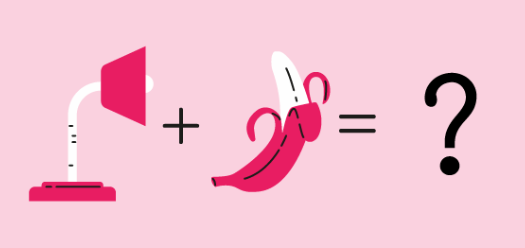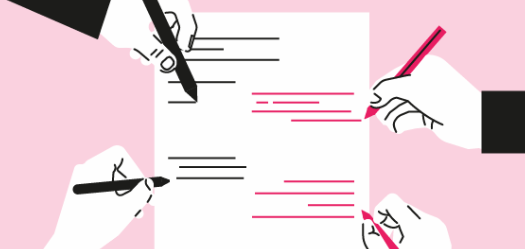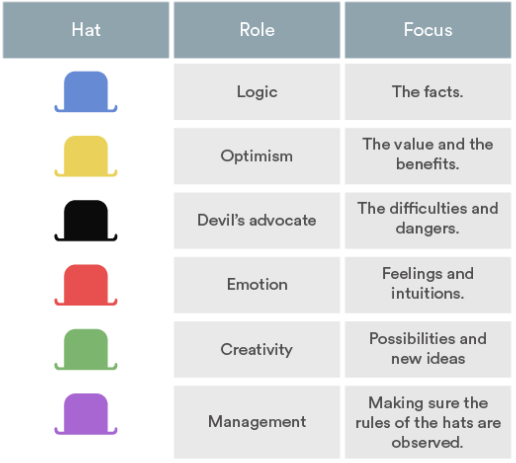
We're all familiar with traditional brainstorming as a method for producing new ideas, but there are many alternative exercises for tackling problems and developing new ideas, both individually and in a group setting.
Ranging from structured to silly, here's a selection of ten simple techniques and exercises to help you get your problem solving juices flowing:
10 Alternative Creative Exercises
1) Storyboarding

If you're trying to design a process, storyboarding can help you see where your collective understanding of a problem supports or conflicts with a proposed solution, and where more thought/research is needed. By developing a visual story to explore the problem at hand as a narrative, your team will be able to see how ideas interact and connect to form a solution.
Sticky notes are your friend. Take a few minutes to have everyone on the team write out their ideas as individual notes. These don't have to be complete thoughts -- physically pinning up quotes, pictures, user info, and the like can help you see new relationships between different components.
Once you have a group of sticky notes to work from, start arranging them on the board as a progression: first this, then that. Organizing your ideas as a continuous series will help you see new connections and eliminate extraneous material that doesn't support your end goal.
2) Forced Connections

This exercise involves bringing together ideas that serve very different needs or interests to form a new concept. You see this sort of thinking all the time in products like the Apple watch, the Swiss Army knife, smartphones, or even sofa beds.
To put this method into practice, bring a bag of random items to your next meeting, or draw up two lists of unrelated items on the board. Ask team members to pick two or more items and explore different ways they can be connected. This technique can produce some silly results, but it's ultimately a helpful way of getting your team out of a creative rut.
3) Brain-Writing

In this exercise, participants simply write down a few rough ideas for solving a particular problem on a piece of paper. Each piece of paper is then passed on to someone else, who reads it silently and adds their own ideas to the page. This process is repeated until everyone has had a chance to add to each original piece of paper. The notes can then be gathered, ready for discussion.
The big advantage of brain-writing is that it makes sure everybody is given the opportunity to have their thoughts and ideas thoroughly considered by the group. This avoids the loudest or most extroverted people unintentionally dominating the sessions.
4) Zero Draft

The Zero Draft is an ideation technique for individuals often used by writers and is essentially a form of focused free-writing. For marketers and agency professionals, it can help focus the first stages of a new project by establishing what you currently know and getting your initial ideas out of your brain and onto paper.
Taking your central theme or topic:
- Write down everything you currently know about the subject.
- Write down what you need or want to know about the subject, but don't currently know.
- Reflect on why the subject is important.
- Add anything else that takes your fancy -- this is a chance to get whatever's floating around in your head out into the world.
The Zero Draft method is all about getting everything you can think of relating to your topic down on paper, so don't be concerned if it looks messy and unfocused. The goal is just to get past the initial block that often plagues creative professionals in the early stages of a new project.
5) S.C.A.M.P.E.R.

S.C.A.M.P.E.R. is essentially a process for expanding and improving upon ideas by testing and questioning them from different angles. For each letter of the mnemonic, ask yourself a related question about your project or the problem at hand:
- Substitute, e.g.: What would happen to the project if we swapped X for Y?
- Combine, e.g.: What would happen to the project if we combined X and Y?
- Adapt, e.g.: What changes would need to be made to adapt this project to a different context?
- Modify, e.g.: What could we modify to create more value on this project?
- Put to another use, e.g.: What other uses or applications might this project have?
- Eliminate, e.g.: What could we remove from the project to simplify it?
- Reverse, e.g.: How could we reorganize this project to make it more effective?
This method forces you to approach your project or problem in unexpected ways. Each question asks you to dig a little deeper into the issue and consider new possibilities.
6) Questioning Assumptions

We all carry assumptions with us -- assumptions about what is and isn't possible, about what people want, what will work, and what won't. This exercise forces us to challenge these and put everything on the table.
Draw up a list of all the assumptions you can think of about your currently project -- true or not -- and discuss the list as a group, questioning each one. Doing this at various stages in your campaign development can spark fresh ideas, as well as identify knowledge gaps.
7) Wishing

This technique encourages your team to let imaginations run wild. Ask participants to dream up the most unattainable, extreme and impractical solutions they can think of to a given problem. Create a list of a few dozen wishes pertaining to the task at hand.
Focusing on a selection of wishes, consider and discuss the ideas in detail, with the aim of triggering new but more realistic concepts to pursue. What makes them so impossible? How can that idea be scaled down? Which features of that wish could we integrate into this other approach? You might be surprised to discover applicable, real-world solutions among your team's wildest wishes.
8) Alter-Egos / Heroes

This is a fun exercise where small groups imagine how they would go about solving a given problem if their team were led by a famous character, fictional or real. How would Cat Woman go about positioning your brand as a thought leader in virtual reality? What would Steve Jobs do to improve your latest communications package? How would Don Draper get your core messages across to millennials?
You can either chose someone you think embodies the right qualities for the job to help develop your vision, or someone at the opposite end of that scale, to explore less conventional ideas.
9) Group Sketching

You don't have to be an artist or a designer to benefit from sketching. Visual thinking can help to trigger and develop ideas that discussion and writing might otherwise leave unturned. Similar to brain-writing, group sketching involves participants building on each other's ideas.
Each member of your team will sketch an image related in a central way to a concept, idea or topic you want to explore further. Each sketch is then passed to someone else, who sketches another related image on the same piece of paper. This is repeated multiple times around the group. The final images are then reviewed and discussed with the aim of discovering connections that individuals hadn't spotted on their own.
10) Six Thinking Hats
There's a whole host of problem solving exercises and tools that help participants to put themselves into the shoes of another. This particular tool was invented by Edward de Bono, a psychologist, author, and consultant who pioneered the technique in his 1985 book Six Thinking Hats. The method involves breaking down ideas into six areas of thought:

When approaching a new problem or project, have each member of your team put on one of these different "hats" for the discussion. Each "hat" represents a unique set of priorities and perspectives that will help focus your discussion and consider the project from a wide variety of angles.
For example, if you're wearing the "Devil's Advocate" hat, it's your job to consider the project's limitations and challenges. It may feel uncomfortable at first to temporarily adopt a very narrow form of thinking, but the extremes can help teams fully explore a project or idea.
This is a modified excerpt from Creative Ideation for Digital Marketers: Theory to Practice by Dani Mansfield
from HubSpot Marketing Blog http://blog.hubspot.com/marketing/creative-exercises-better-than-brainstorming

No comments:
Post a Comment